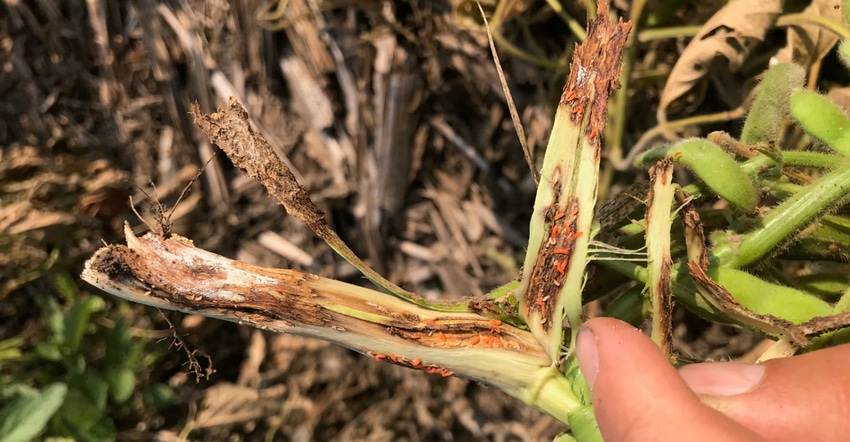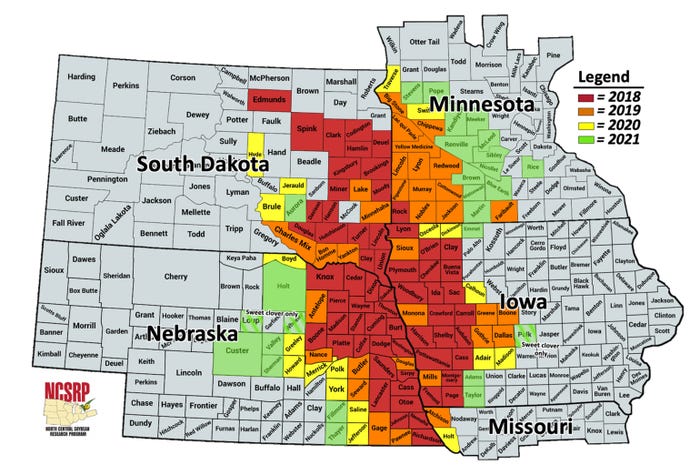
Soybean gall midge continues to make its way across the Upper Midwest with no sign of stopping as farmers and researchers look for control options.
Farmers reported this invasive pest in 26 more counties during 2021, making soybean gall midge established in 140 counties across five states in the Upper Midwest. It attacks soybean plants and kills them, says Kevin Rice, University of Missouri Extension entomologist.
In heavily infested fields, reports showed 100% yield loss from the field edge up to 100 feet, with about 20% yield loss within 200 and 400 feet from the edge.
“This pest causes a great deal of damage, and we currently have no management practices to stop it from spreading across the state,” Rice says.
Spread of invasive pest
Soybean gall midge first arrived in Nebraska in 2011, and by 2021, it was reported to be in four other states — Iowa, South Dakota, Minnesota and Missouri. The Soybean Gall Midge Alert Network, which tracks the pest, showed that by county, the greatest spread last year occurred in Minnesota. However, actual numbers detected in those counties were low. Nebraska remains a hot spot for the pest.
“This invasive insect was actually newly described to science in 2011,” Rice explains. “No scientists had ever defined it before. But it didn't just appear in the Midwest. It's more likely that it had been studied and unintentionally shipped into the region.”

The soybean gall midge does not move as fast as some other invasive pests. However, with no control options on the horizon and a strong economic impact to soybean growers, it is one that groups such as The Soybean Gall Midge Alert Network are tracking and studying.
While soybean gall midge is an invasive pest, it is not spreading as rapidly as stinkbugs. Rice says it is because of the insect’s biology. “It's not a strong flyer,” he notes, “but we do expect it to spread to additional counties.”
In Missouri, MU Extension agronomists first detected soybean gall midge in Atchison County in 2019 and a year later in Holt County. Looking at a map of the Upper Midwest, the insect appears in counties along the Missouri River and then moves out from there, infecting fields in neighboring counties. That is unwelcome news for soybean growers, as this pest starts along the field edges causing complete yield loss.
Cause of plant death
Soybean gall midge feeds underneath the epidermis of the skin, Rice explains. “It causes darkening at the base, and the plant becomes very brittle and then snaps at the base.”
Larvae inflict plant damage. At V2, farmers may see swollen outgrowths like cysts at the base of the stem. There will be blackening of the base followed by leaf wilting, Rice says.
Farmers can peel back the outer layer of the epidermis near the darkened base to reveal either translucent or white-colored maggots (early instars) or bright orange maggots (late instars). Soybean stems break, and plant death typically occurs at V5.
Later instar larvae leave the stem and overwinter in the soil, and then emerge in late spring. The adults appear similar to the hessian fly.
Treatment options elusive
To date, there are no research-based control options that work on soybean gall midge. Because of its extended emergence and multiple overlapping generations, timing of insecticide application is difficult.
According to University of Nebraska researchers, the duration of adult emergence from overwinter sites is an average of 36 days across 14 sites in east-central Nebraska, so management is a problem. Also seed treatments don’t appear to be effective.
Studying the soybean gall midge and control options is limited in Missouri. Since the pest is not widespread, Rice will not introduce it to other locations simply for research purposes because that would aid in the spread. Instead, he is asking for farmers to report soybean gall midge damage to their local Extension office.
“The more reports that we get in Missouri will allow us to do field trials with insecticides and emergence to figure out what works and what doesn't for management,” he says.
Other states in the Midwest are asking soybean growers to report soybean gall midge as well. The Soybean Gall Midge Alert Network, sponsored by the North Central Soybean Research Program, United Soybean Board, Nebraska Soybean Checkoff, Nebraska Extension, North Central IPM Center and USDA-National Institute of Food and Agriculture, continues to test control options.
In 2021, the group screened U.S. soybean germplasm for resistance. In addition, management practices such as early-season hilling were tested and showed the greatest potential for lessening injury. More research is anticipated to help farmers manage soybean gall midge as it spreads.
About the Author(s)
You May Also Like






